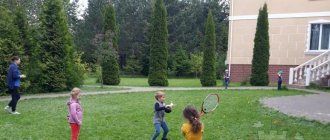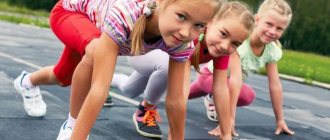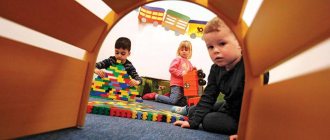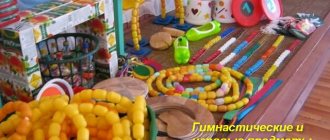The daily routine in kindergarten is organized in accordance with SanPiN standards. It is planned in such a way that children can alternate active activities with quiet ones and have enough time for a walk, eating, and healthy sleep. Teachers advise parents and at home to adhere to at least approximately the daily routine that is established in the kindergarten.
In order for a child to grow healthy and active, it is necessary to properly organize his activities throughout the day. In solving this problem, the daily routine is very important. It is a specific system that helps distribute the time of sleep and wakefulness, meals, hygiene procedures, classes, games and other activities of children.
The child’s condition, both physical and mental, completely depends on compliance or non-compliance with the established regime. Even slight delays in sleeping or eating can negatively affect the overall well-being of the baby.
What is the importance of a kindergarten regime for a child?
If the daily routine in kindergarten corresponds to the age characteristics of the child, then it will help strengthen the baby’s health and also guarantee his good performance. At the same time, it provides a change in children’s activities and protects them from overwork. A child who gets used to the regime is prepared in advance for new activities, as a result of which they are more fruitful and effective. Children who follow a daily routine have a more stable psyche and are less prone to viral diseases.
When teachers plan the daily schedule in kindergarten, they first of all take into account the fact that the child’s activity and performance varies throughout the day. Children are most active from eight o'clock in the morning to twelve o'clock in the afternoon and from four o'clock in the afternoon to six o'clock in the evening. The minimum performance in children is from approximately two o'clock to four o'clock in the afternoon. Therefore, the first half of the day is devoted to developmental activities, taking into account the fact that children at this time can be actively involved in developmental activities.
| Performance in children | |
| highest | lowest |
| from 8:00 to 12:00 from 16:00 to 18:00 | from 14:00 to 16:00 after 20:00 |
Preschool educational institutions practice full compliance with the daily routine by children. However, parents can give some indulgences to their child on weekends, which cannot but affect his condition later. On Monday it is quite difficult for such children, as they get tired quickly.
Throughout preschool childhood, the regime in kindergarten undergoes only minor changes. The duration of daytime sleep and walking time change slightly.
One day in kindergarten, rough plan
Most preschool institutions work twelve hours (from 7.00 to 19.00). The daily routine in the kindergarten is drawn up accordingly: starting at seven in the morning, children are received, ending with them going home at seven in the evening.
- Morning. In the morning, the teacher receives children, conducts exercises and organized educational activities (classes) with them. Children also have breakfast in the morning, and in their free time they can play or chat with other children.
- Reception of children. The day begins with the teacher receiving the children from their parents. Here it is important to create a positive emotional mood among the guys in the entire group. When a teacher receives a child, he is interested in his state of health and can also answer some questions from parents.
- Morning work-out. In order to give children a boost of energy for the whole day, exercises are included in the kindergarten schedule in the morning, which involves a number of specific physical exercises. Daily exercises help strengthen the musculoskeletal system of children, making them more resilient and healthy. Exercises can be carried out either by the teacher himself or by a physical education worker. Usually, morning exercises are performed with musical accompaniment in the gym for physical education classes (except for nursery and junior groups).
- Breakfast. The daily routine in preschool educational institutions strictly regulates the time children eat, in particular, breakfast.
- Classes (educational activities). The teacher conducts classes in a playful way so that the children better understand the material. The duration of classes varies in different groups, taking into account the age of the children. On average they last from 10 to 25 minutes.
The daily routine of the kindergarten includes the following types of activities:
- cognitive development,
- mathematical development,
- speech development,
- familiarization with fiction,
- productive activities (modeling, design, appliqué),
- creative activity,
- music,
- Physical Culture.
- Day. The daily schedule of the kindergarten includes a walk, lunch and nap.
- The kindergarten routine certainly includes a daytime walk for children. It promotes children's health, hardening, development of movements and their general cognitive development. Usually, walks in kindergarten are carried out in any weather. The reasons for its cancellation are strong gusts of wind, heavy rain, heavy snowfall and blizzards, severe frost, etc. During drizzling rain and light snowfall, children walk on the verandas, which are specially provided for this purpose. In different age groups, the walk lasts its own specific time.
- After the walk, the children have lunch. In order to restore energy after cognitive and active activity, the child is offered to eat a full lunch, which consists of salad, first, second and third courses.
- Preschool children simply need daytime sleep, so it must be included in the daily routine in kindergarten. The duration of sleep depends on the age of the children. Typically, daytime sleep lasts from one and a half to three hours.
- Evening. Evening is considered to be the time after bedtime and before the children go home. During these hours, children have more time for independent play activities, and the teacher can carve out a few minutes for individual work with this or that child.
- After the children wake up, they go to lunch. This is a light snack that will help your child not feel hungry until dinner.
- For older children (senior and preparatory groups), an additional walk is included in the kindergarten schedule after afternoon tea.
- Educational activities are also provided in the evening. Classes are held in groups of younger and middle age. It could be modeling or drawing, music or physical education. In the evening, children are given more time for independent activities, role-playing or board games.
- Around five o'clock in the evening, the children sit down to dinner, and after that they begin to be taken home.
The concept and meaning of the daily routine. Its features in different age groups
1. The concept and meaning of the daily routine. Its features in different age groups
The daily routine is of great importance for the health and physical development of children. Constant time for eating, sleeping, walking, playing and studying is what I.P. Pavlov called it an external stereotype - a prerequisite for the proper upbringing of a child.
The daily routine is a clear routine of life during the day, providing for the alternation of wakefulness and sleep, as well as the rational organization of various types of activities. A correct regimen that corresponds to the child’s age-related capabilities improves health, ensures efficiency, successful implementation of various activities, and protects against overwork.
The physiological basis that determines the nature and duration of activity is the level of performance of the cells of the cerebral cortex, therefore it is so important not to exceed the performance limit of the central nervous system, as well as to ensure its full functional recovery after work. The degree of morphofunctional maturity of the organism determines the content of the daily routine and the duration of its main elements, among which the following are distinguished:
- dream;
– staying outdoors (walking);
– educational and training activities;
– gaming activities and activities of one’s own choice (reading, music, drawing and other creative activities, sports);
– self-care, family assistance;
– meals;
- personal hygiene.
Sleep ensures complete functional restoration of all body systems. The physiological need for sleep in children of different ages depends on the characteristics of their nervous system and health status. In the preschool period, both night and daytime sleep are required, regardless of whether the child attends a preschool educational institution, a short-stay group or not. A good night's sleep is important for both preschoolers and schoolchildren.
A child under 5 years old is supposed to sleep 12.5–12 hours a day, at 5–6 years old – 11.5–12 hours (of which approximately 10–11 hours at night and 1.5–2.5 hours during the day). The time allotted for night sleep is from 9–9 hours 30 minutes in the evening to 7–7 hours 30 minutes in the morning. Preschool children sleep once during the day. They are put to bed so that they wake up at 15-15 hours 30 minutes. It is not advisable to organize a daytime nap later - this would inevitably lead to a later bedtime at night. A six-hour wakefulness in the afternoon is exactly the period of time during which the child will play enough to feel the need for rest.
Staying in the open air (walking) is the most effective type of recreation, due to increased blood oxygenation, replenishment of ultraviolet deficiency, allowing for the hardening of the body and an increase in physical activity. Walks are especially important for preschool children: in winter, at least 4–4.5 hours, and in summer, if possible, all day. The walk is not carried out at an air temperature below -15 °C and a wind speed of more than 15 m/s for children under 4 years old, and for children 5–7 years old at an air temperature below -20 °C with a wind speed of more than 15 m/s (for average stripes).
Educational and educational activities.
When constructing a rational training regimen, one should take into account the biorhythms of the functioning of the child’s body. In most healthy children, the greatest excitability of the cerebral cortex and performance are determined in the morning period - from 8:00 to 12:00 hours and in the evening - from 16:00 to 18:00 hours.
Training and education programs at preschool educational institutions provide for developmental activities. In the younger group, the duration of classes is 10–15 minutes (10 lessons per week), in the middle group (4–5 years old) - 20 minutes (10 lessons per week), in the older group (5–6 years old) - two lessons per week. day for 20–25 minutes with a break of 10 minutes. In the preparatory group (6–7 years old) – 3 lessons a day are held for 25–30 minutes, taking on the nature of training. Hygienic studies have shown that classes on speech development, literacy, mathematics, and familiarization with the outside world are more tiring than modeling, drawing, and design. Physical education and music (dynamic exercises) reduce or relieve fatigue.
One of the means of physical education is the correct implementation of a regime compiled for each age group of children, taking into account their psychophysiological characteristics. If the regime is carried out correctly, then children are calm, actively engaged, play, eat well, fall asleep quickly and sleep soundly, and wake up cheerful and cheerful.
The daily routine for each age group indicates the approximate time that elapses from the inclusion of the first child in this routine process until the last child ends it.
The younger the children are, the less independent they are, the more important it is to maintain the principle of gradualness when carrying out all routine moments.
It is important to make seasonal changes to your daily routine. The program offers modes for both cold and warm seasons.
In winter, due to the weather conditions and the large number of activities with children, the child’s time outdoors during the day is somewhat reduced.
Therefore, a walk is of particular importance, which is extremely important to carry out systematically at least 2 times a day. In summer and other warm periods of the year, the daily duration of children’s stay in the fresh air increases, since the number of classes is reduced to one and almost all routine processes are carried out on the site, if possible. Most of the activities with children are physical education, music, familiarization with the environment, etc. – should also be carried out in the fresh air.
In order for a walk to be not only useful, but also interesting, its content should be properly planned: conduct outdoor games, sports entertainment, introduce children to their surroundings, to nature, to the work of adults on the site, on the street, to involve children in work that is feasible for them. in the garden, going on excursions outside the site, etc.
When implementing the regime, it is necessary to ensure a timely change in the types of activities of children.
When planning work, the teacher provides that classes in which children move little (on the development of elementary mathematical concepts, drawing, etc.) are replaced by physical education and music classes. If children show signs of fatigue (excitement, inattention, motor restlessness, etc.), a physical education minute is held.
During the periods of time allocated for independent activity of children, much attention is paid to ensuring their physical activity.
Based on the best experience of preschool institutions and the achievements of pedagogical science, an approximate daily routine has been developed for each age group of a preschool educational institution, which is included in the “Education Program in Kindergarten”. The standard regime is designed for a 12-hour stay of children in a preschool institution.
Daily routine (in warm weather)
| Regime processes | 1 junior gr. | 2 jr. gr. | average gr. | senior gr. | prepared gr. |
| Getting up, morning toilet | 6.30–7.30 | 6.30–7.30 | 6.30–7.30 | 6.30–7.30 | 6.30–7.30 |
| Reception, examination, games, morning. gymnastics | 7.00–8.00 | 7.00–8.20 | 7.00–8.25 | 7.00–8.35 | 7.00–8.35 |
| Preparation for breakfast, breakfast | 8.00–8.30 | 8.20–8.55 | 8.25–8.55 | 8.35–9.00 | 8.35–8.55 |
| Games, preparation for a walk, going out | 8.30–8.50 | 8.55–9.15 | 8.55–9.20 | 9.00–9.15 | 8.55–9.05 |
| Lesson (on site) | 8.50–9.00 | 9.15–9.30 | 9.20–9.40 | 9.15–9.45 | 9.05–9.35 |
| Games, observations, air and sun treatments | 9.15–11.30 | 9.30–11.15 | 9.40–11.35 | 9.45–12.15 | 9.35–12.10 |
| Returning from a walk, water procedures, games | 11.30–11.50 | 11.15–11.40 | 11.35–12.00 | 12.15–12.30 | 12.10–12.30 |
| Preparing for lunch, lunch | 11.50–12.30 | 11.40–12.20 | 12.00–12.35 | 12.30–13.00 | 12.30–13.00 |
| Getting ready for bed, sleep | 12.30–15.10 | 12.20–15.10 | 12.35–15.10 | 13.00–15.00 | 13.00–15.00 |
| Wake up, afternoon snack | 15.15–15.35 | 15.10–15.30 | 15.10–15.30 | 15.00–15.25 | 15.00–15.25 |
| Preparing for a walk, games | 15.35–15.50 | 15.30–15.50 | 15.30–16.00 | 15.25–16.10 | 15.25–16.20 |
| Walk, play outside, children go home | 16.40–19.00 | 16.30–19.00 | 16.40–19.00 | 16.50–19.00 | 16.55–19.00 |
Daily routine (in cold weather)
| Regime processes | 1 junior gr. | 2 jr. gr. | average gr. | senior gr. | prepared gr. |
| Getting up, morning toilet | 6.30–7.30 | 6.30–7.30 | 6.30–7.30 | 6.30–7.30 | 6.30–7.30 |
| Reception, examination, games, morning. gymnastics | 7.00–8.00 | 7.00–8.20 | 7.00–8.25 | 7.00–8.30 | 7.00–8.30 |
| Preparation for breakfast, breakfast | 8.00–8.30 | 8.20–8.55 | 8.25–8.55 | 8.30–8.55 | 8.30–8.50 |
| Preparation for classes | 8.20–9.00 | 8.55–9.00 | 8.55–9.00 | 8.55–9.00 | 8.50–9.00 |
| Classes | 8.40–9.15 | 9.00–9.35 | 9.00–9.50 | 9.00–10.50 | 9.00–11.05 |
| Games, preparation for a walk, walk | 9.15–11.30 | 9.35–11.35 | 9.50–11.50 | 10.50–12.25 | 11.05–12.35 |
| Returning from a walk or game | 11.30–12.10 | 11.35–12.00 | 11.50–12.15 | 12.25–12.40 | 12.35–12.45 |
| Preparing for lunch, lunch | 11.50–12.30 | 12.00–12.40 | 12.15–12.50 | 12.40–13.10 | 12.45–13.15 |
| Getting ready for bed, sleep | 12.30–15.00 | 12.40–15.00 | 12.50–15.00 | 13.10–15.00 | 13.15–15.00 |
| Wake up, afternoon snack | 15.00–15.15 | 15.00–15.15 | 15.00–15.15 | 15.00–15.15 | 15.00–15.15 |
| Games, self. artist activities, classes | 15.15–15.40 | 15.15–15.50 | 15.15–16.00 | 15.15–16.10 | 15.15–16.20 |
| Preparing for a walk, walk, games, children going home | 16.20–19.00 | 16.30–19.00 | 16.40–19.00 | 16.50–19.00 | 16.55–19.00 |
Thus, for each age period, a regimen is recommended that takes into account the physiological needs and physical capabilities of children of a given age.
The child’s emotionally positive state during the day and his successful perception of the surrounding reality depend on adequate and timely feeding, high-quality and sufficient sleep, and pedagogically well-organized wakefulness. A certain sequence of their alternation should be observed: sleep, feeding, wakefulness.
- Organization of the daily routine in home education
Age-related characteristics of the mental development of children 3–4 years old.
At the age of 3–4 years, the child gradually leaves the family circle. His communication becomes non-situational. An adult becomes for a child not only a family member, but also a bearer of a certain social function. The child’s desire to perform the same function leads to a contradiction with his real capabilities. This contradiction is resolved through the development of play, which becomes the leading activity in preschool age.
The main feature of the game is its convention: performing certain actions with certain objects presupposes their attribution to other actions with other objects. The main content of the play of younger preschoolers is actions with toys and substitute objects. The game duration is short. Younger preschoolers are limited to playing with one or two roles and simple, undeveloped plots. Games with rules are just beginning to take shape at this age.
A child’s visual activity depends on his ideas about the subject. At this age they are just beginning to form. Graphic images are poor. Some children's images lack detail, while others' drawings may be more detailed. Children can already use color.
Modeling is of great importance for the development of fine motor skills. Younger preschoolers are able to sculpt simple objects under the guidance of an adult.
It is known that application has a positive effect on the development of perception. At this age, children have access to the simplest types of appliqué.
Constructive activity in early preschool age is limited to the construction of simple buildings according to a model and design.
In early preschool age, perceptual activity develops. Children move from using prestandards—individual units of perception—to sensory standards—culturally developed means of perception. By the end of primary preschool age, children can perceive up to five or more shapes of objects and up to seven or more colors, are able to differentiate objects by size, orient themselves in the space of a kindergarten group, and with a certain organization of the educational process, in the premises of the entire preschool institution.
Memory and attention develop. At the request of an adult, children can remember 3-4 words and 5-6 names of objects. By the end of primary preschool age, they are able to remember significant passages from their favorite works.
Visual and effective thinking continues to develop. At the same time, transformations of situations in some cases are carried out on the basis of targeted tests, taking into account the desired result. Preschoolers are able to establish some hidden connections and relationships between objects.
In early preschool age, imagination begins to develop, which is especially clearly manifested in play, when some objects act as substitutes for others.
The relationships between children are determined by norms and rules. As a result of targeted influence, they can learn a relatively large number of norms, which serve as the basis for evaluating their own actions and the actions of other children.
Children's relationships are clearly manifested in play activities. They rather play nearby than actively interact. However, already at this age stable selective relationships can be observed. Conflicts arise mainly over toys. The child's position in the peer group is largely determined by the opinion of the teacher.
In early preschool age, one can observe a subordination of motives for behavior in relatively simple situations. Conscious control of behavior is just beginning to emerge; In many ways, a child’s behavior is still situational. At the same time, one can also observe cases of the child himself limiting his own motives, accompanied by verbal instructions. Self-esteem begins to develop, and children are largely guided by the teacher’s assessment. Their gender identification also continues to develop, which is manifested in the nature of the toys and stories they choose.
Approximate daily routine for children who do not attend kindergarten (according to V.E. Vasilyeva and A.F. Kaptelin)
| 1 | Waking up, morning exercises, water procedures, washing | 7–8.00 |
| 2 | Breakfast | 8.40 |
| 3 | Games and activities at home | 9.10 -10.00 |
| 4 | Walking and playing outdoors | 10.10 |
| 5 | Dinner | 12.30–13.20 |
| 6 | Daytime sleep (with the transom, window or veranda open) | 13.30–15.30 |
| 7 | Free time for quiet games and preparation for afternoon tea | 15 -16.00 |
| 8 | Afternoon snack | 16.00 |
| 9 | Walking and playing outdoors | 16.30 |
| 10 | Dinner | 18.30 |
| 11 | Free time, quiet games | 19 -20.00 |
| 12 | Night sleep |
Hours on weekends and holidays
If a child attends a kindergarten, his home regime on weekends and holidays must correspond to the preschool regime. The established daily routine should not be disrupted without a serious reason. If possible, it should be preserved even when the child’s living conditions change (for example, if parents send him to relatives for a while or take a long trip by rail with him). In certain cases, deviations from the regime are allowed within 30 minutes, but no more.
The accuracy of the daily routine largely depends on how the baby himself regulates his behavior based on developed habits and self-care skills. Experience shows that strict adherence to the established routine day after day gradually develops the child’s active desire to carry out the routine independently, without prompting from adults, without coercion, and this contributes to the formation of such important qualities of behavior as organization and self-discipline, a sense of time, and the ability to save it.
Most preschoolers attend kindergarten, where they receive age-appropriate meals four times a day. The home diet of such an “organized” child should complement, and not replace, the diet of the kindergarten. For this purpose, teachers post the daily menu in each group so that parents can familiarize themselves with it. Therefore, when taking your child home, do not forget to read it and try to give your baby at home exactly those foods and dishes that he did not receive during the day. On weekends and holidays, try to stick to the kindergarten menu.
The general routine of life is also very important. Unfortunately, in many families, especially young ones, the regime is neglected, and this inevitably harms the child.
According to our observations, children attending preschool institutions most often get sick after weekends and holidays. And this happens because at home the child is not provided with the regime to which he is accustomed, to which he was tuned in in kindergarten: they put him to bed later in the evening, cancel naps during the day, replace walks with games at home, allow him to watch TV shows as much as he wants, and overfeed him with sweets. All this negatively affects the fragile child’s body, disrupts the functions of all its organs and systems, thereby inevitably weakening the protective mechanisms.
The child’s home regime should be a continuation of the child’s institution regime, and if the child does not go to kindergarten, then at home he needs an age-appropriate and strictly observed daily routine. Without this, it is difficult to expect success from hardening.
On weekends, as on weekdays, you should not watch TV for more than 40, or at most 60 minutes. Rhythmic light stimulation coming from the TV screen has an adverse effect on the child’s brain and disorganizes its activity. These 40–60 minutes also include time for computer games.
On weekends you should spend more time outdoors. Walking with the whole family is especially beneficial both physically and psychologically.
On weekends, the child should take a walk, get some sleep, in a word – relax. Try not to get out of the usual rhythm of life, do not disturb the usual daily routine. By adhering to such simple rules, you and your baby will not waste wonderful minutes of time, happily using them to be together, take a walk, and play. You will become friends with a good mood and well-being, and fatigue and lethargy will have to retreat.
What means help solve these problems?
First of all, the habit of following a routine developed in early childhood. Usually the child wants to somehow complete what he is doing (and this can only be welcomed). Therefore, you should warn your baby in advance, 10–15 minutes in advance, that you need to go to bed soon. And when this time comes, insist that the child does not linger.
The gradual switch from play to sleep is facilitated by the child’s habit of undressing on his own. By the age of three, a child can undress almost independently and neatly fold his clothes. Over the following years, these skills are improved.
The best clothes for sleeping are pajamas, which, depending on the season, can be flannelette, knitted or chintz. On hot days, children can sleep in panties (but not the ones they played in).
Let us remind you: in all seasons of the year, during the day, if possible, the child should sleep in the air. If this is not possible, then he must be dressed and covered in such a way that the window, transom or vent can remain open during the entire sleep time. (The air temperature in the room should not drop below plus 15°).
It is also very important to provide access to fresh air during nighttime sleep. If in winter the room gets too cold, it should be well ventilated before the child is put to bed.
It is advisable for the child to get up immediately after waking up. It should be borne in mind that the transition from sleep to wakefulness occurs differently in children: for some it is almost instantaneous, while for others it takes 5-10 minutes to finally wake up.
Dressing yourself and fastening all the buttons is somewhat more difficult for a child than undressing. Throughout preschool age, children should strengthen the skill of dressing themselves and carefully washing and combing their hair after sleep.
Walks.
A walk, long enough and done daily, is the most important means of improving a child’s health and his full and physical development. During the cold season, the child should walk at least 3-4 hours a day. If the weather is unfavorable, the walk can be shortened, but not cancelled. During the cold season, the mobility of some children is limited by dressing them incorrectly or wrapping them up too much. Bulky clothes interfere with playing with peers, throwing snowballs, making snow “women,” or sledding down a hill; the child not only loses the joy of these activities, but begins to lag significantly behind in physical development. In such children, the body's adaptability to cold and heat and resistance to the effects of harmful microorganisms decrease. They are often either too thin or too fat. Inharmonious physical development leads to a delay in improving motor skills.
Often walks are shortened because the adult who walks with the children is cold, because he moves much less than them. Therefore, it is very important that the adult is dressed and shod appropriately.
The combined effect of cool air and physical exercise is an effective method of hardening and training the most important functions of the body.
With the onset of warm spring days, children spend almost entire days outdoors. In spring, it is also very important to ensure that the child is dressed for the weather. If parents are not in a hurry to lighten the child’s clothes, then in the winter he will overheat. It’s hard for him, he unbuttons and sometimes takes off his coat - but this can lead to illness. Clothing should be lightened gradually: first, change a fur coat or warm coat to a spring coat with a knitted blouse or sweatshirt, then free the child from leggings, warm socks, etc. Later, on even warmer days, you can allow the child to walk with open arms and legs and, finally, in shorts. In the summer, when children develop the habit of walking around lightly dressed, you can leave them in lighter clothes on cool days.
Thus, serious organizational and educational work is needed among parents to streamline the home regime and bring it into line with that established in kindergarten. Parents' attention should be drawn to organizing an evening walk, a night's sleep, and on weekends to proper rest in the air, and regulating the viewing of television programs, especially before bedtime.
Formation of cultural and hygienic skills in the daily routine
Plan of activities for the education of cultural and hygienic skills in regime processes in their age group (Second Junior)
| Regime process | Objectives of developing cultural and hygienic skills | Contents of cultural and hygienic skills | Parenting techniques |
| Admission of children | Cultivate a caring attitude towards your belongings and your appearance. | Take off clothes and shoes (unfasten front buttons, Velcro fasteners); Carefully fold removed clothes in a certain order. Availability of a handkerchief. | Demonstration and explanation, exercise and control, evaluation, creating a situation of success. |
| Washing | Develop the skill of using soap and a personal towel. | Use soap correctly, carefully wash your hands, face, ears; Wipe dry after washing with a personal towel, hang the towel in place. | Demonstration and explanation, exercise and control, evaluation, use of artistic words, musical works. |
| Feeding | Develop basic table behavior skills. | Correctly use tablespoons, teaspoons, forks, and napkins; do not crumble bread, chew food with your mouth closed, do not talk with your mouth full. | Demonstration and explanation, exercise and control, game situations, use of literary words, illustrations. |
| Dressing | Teach children how to dress. | Correctly put on clothes and shoes, fasten buttons, put on tights, etc. | Demonstration and explanation, exercise and control, assessment, creating a situation of success, using dressing algorithms. |
| Going to bed | Cultivate a caring attitude towards your things. | Carefully place clothes on the high chair. Dress yourself after sleep. | Demonstration and explanation, exercise and control. |
Ways to form cultural and hygienic skills (CHS)
The formation of CGN coincides with the main line of mental development at an early age - the formation of instrumental and correlative actions. The first involves mastering an object-tool with which a person acts on another object, for example, eating soup with a spoon. With the help of correlating actions, objects are brought into the corresponding spatial positions: the baby closes and opens boxes, puts soap in a soap dish, hangs a towel by a loop on a hook, fastens buttons, laces up shoes. Adults must remember this and create appropriate conditions: the bathroom (toilet) room must have hooks, shelves located at a level convenient for the child, towels must have loops, etc.
As they are mastered, CGNs are generalized, separated from the corresponding subject and transferred to a playful, imaginary situation, thereby influencing the formation of a new type of activity - games. In games, the child reflects (especially at first) everyday actions, primarily because they are familiar to him and have been repeatedly performed in relation to him. The play activities of children of this age are maximally developed. So, if at five to seven years old a child can replace an action with a word, for example, “already eaten,” then at an early age he diligently feeds the bear the first, second and third course. To speed up the formation of CGN, it is necessary to remind the child during games: “You always wash your hands before eating. Did you remember to wash your daughter’s hands?” Thus, acquired CGNs enrich the content of children’s games, and games, in turn, become an indicator of the assimilation of CGNs.
KGN are associated not only with the game. They underlie the first type of work activity available to a child – self-care work. The baby has learned to put on a dress, tights, shoes and begins to master the sequence of dressing: what comes first, what comes next. At the same time, the formed skills are combined, forming a scheme of actions in situations of dressing, washing, going to bed, etc. That is, the units of action are enlarged, when the baby no longer works with one element, but with a group of them. Gradually, labor actions are combined into complex forms of behavior. At the same time, he transfers the attitude towards himself to the attitude towards objects, begins to monitor the cleanliness of not only his appearance, but also his things, and order.
Thus, it can be argued that the formed CPGs provide a transition to more complex types of activities, stimulate their development, and enrich the content.
Daily routine in kindergarten for younger and older children
The daily routine in kindergarten differs for younger and older children. Teachers of younger groups pay more attention to the development of cultural and hygienic skills than directly to educational activities. The classes themselves are shorter here, lasting 10-15 minutes. The teacher conducts the lesson in subgroups. Children's walks are shorter in duration because a lot of time is spent on the process of dressing and undressing. Because of this, there are no walks for small children in the evening.
As children age, not only the difficulty of the activity increases, but also its duration. Therefore, there is less time for daytime sleep, and walking, on the contrary, increases.
Organizing a daily routine in a preschool educational institution is important for children. Parents should know how their child’s day is planned in kindergarten, and try to adhere to this schedule at home.
Benefits of kindergarten education
Benefits of kindergarten education
Not all children attend preschool institutions - some have mothers who do not work, others have grandmothers. Most kids have to go to kindergarten, spending almost the whole day there. This necessity is not a disadvantage of parenting. On the contrary, it teaches children the perception of an organized team, whose life is subject to a certain routine.
Advantages of regime education
- The daily routine creates conditions for independence skills. Toddlers learn to dress, clean up after themselves, follow hygiene rules, and take care of their natural needs faster than children at home.
- In a preschool institution, a certain time is allocated not only for eating and sleeping, but also for group games, thereby promoting the development of the ability to share toys, help each other, relieving children of egocentrism.
- Much attention is paid to classes. Their content depends on the age group, but each lesson is selected taking into account the mental development of children. During classes, children learn logical thinking, oral speech, and demonstrate their musical and artistic abilities.
- The daily routine also includes hours for physical exercise and walks in the fresh air, which allows children to grow up healthier. Mobility makes it possible to usefully spend accumulated energy. This promotes good appetite and sleep.
By obeying the routine in kindergarten, children become more organized in the family. At the same time, they learn to moderate their personal desires and more often take into account the needs of people close to them.






